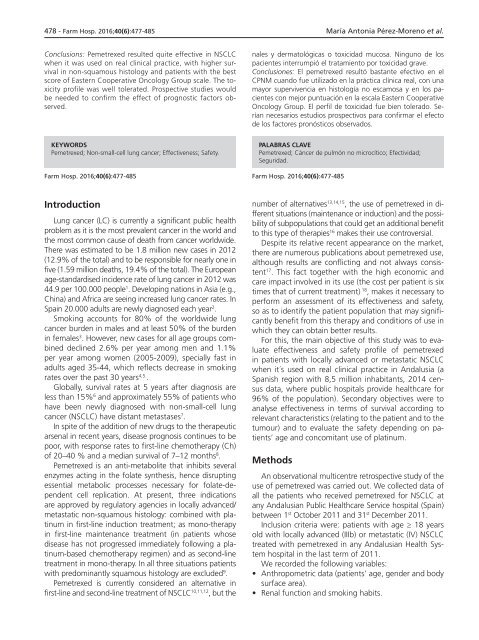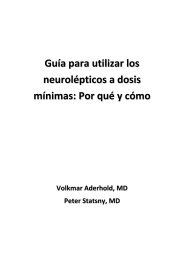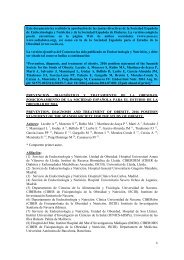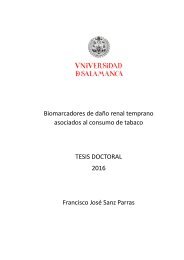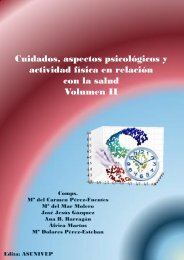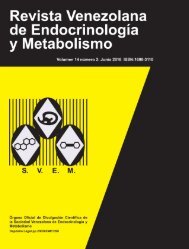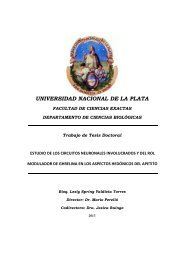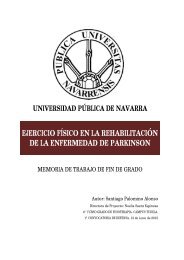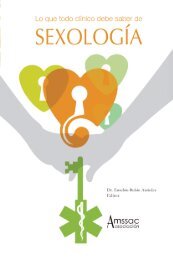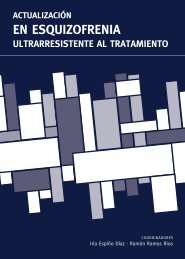Noviembre-Diciembre
156_v40n6(1)
156_v40n6(1)
Create successful ePaper yourself
Turn your PDF publications into a flip-book with our unique Google optimized e-Paper software.
478 - Farm Hosp. 2016;40(6):477-485 María Antonia Pérez-Moreno et al.<br />
Conclusions: Pemetrexed resulted quite effective in NSCLC<br />
when it was used on real clinical practice, with higher survival<br />
in non-squamous histology and patients with the best<br />
score of Eastern Cooperative Oncology Group scale. The toxicity<br />
profile was well tolerated. Prospective studies would<br />
be needed to confirm the effect of prognostic factors observed.<br />
nales y dermatológicas o toxicidad mucosa. Ninguno de los<br />
pacientes interrumpió el tratamiento por toxicidad grave.<br />
Conclusiones: El pemetrexed resultó bastante efectivo en el<br />
CPNM cuando fue utilizado en la práctica clínica real, con una<br />
mayor supervivencia en histología no escamosa y en los pacientes<br />
con mejor puntuación en la escala Eastern Cooperative<br />
Oncology Group. El perfil de toxicidad fue bien tolerado. Serían<br />
necesarios estudios prospectivos para confirmar el efecto<br />
de los factores pronósticos observados.<br />
KEYWORDS<br />
Pemetrexed; Non-small-cell lung cancer; Effectiveness; Safety.<br />
Farm Hosp. 2016;40(6):477-485<br />
PALABRAS CLAVE<br />
Pemetrexed; Cáncer de pulmón no microcítico; Efectividad;<br />
Seguridad.<br />
Farm Hosp. 2016;40(6):477-485<br />
Introduction<br />
Lung cancer (LC) is currently a significant public health<br />
problem as it is the most prevalent cancer in the world and<br />
the most common cause of death from cancer worldwide.<br />
There was estimated to be 1.8 million new cases in 2012<br />
(12.9% of the total) and to be responsible for nearly one in<br />
five (1.59 million deaths, 19.4% of the total). The European<br />
age-standardised incidence rate of lung cancer in 2012 was<br />
44.9 per 100.000 people 1 . Developing nations in Asia (e.g.,<br />
China) and Africa are seeing increased lung cancer rates. In<br />
Spain 20.000 adults are newly diagnosed each year 2 .<br />
Smoking accounts for 80% of the worldwide lung<br />
cancer burden in males and at least 50% of the burden<br />
in females 3 . However, new cases for all age groups combined<br />
declined 2.6% per year among men and 1.1%<br />
per year among women (2005-2009), specially fast in<br />
adults aged 35-44, which reflects decrease in smoking<br />
rates over the past 30 years 4,5. .<br />
Globally, survival rates at 5 years after diagnosis are<br />
less than 15% 6 and approximately 55% of patients who<br />
have been newly diagnosed with non-small-cell lung<br />
cancer (NSCLC) have distant metastases 7 .<br />
In spite of the addition of new drugs to the therapeutic<br />
arsenal in recent years, disease prognosis continues to be<br />
poor, with response rates to first-line chemotherapy (Ch)<br />
of 20–40 % and a median survival of 7–12 months 8 .<br />
Pemetrexed is an anti-metabolite that inhibits several<br />
enzymes acting in the folate synthesis, hence disrupting<br />
essential metabolic processes necessary for folate-dependent<br />
cell replication. At present, three indications<br />
are approved by regulatory agencies in locally advanced/<br />
metastatic non-squamous histology: combined with platinum<br />
in first-line induction treatment; as mono-therapy<br />
in first-line maintenance treatment (in patients whose<br />
disease has not progressed immediately following a platinum-based<br />
chemotherapy regimen) and as second-line<br />
treatment in mono-therapy. In all three situations patients<br />
with predominantly squamous histology are excluded 9 .<br />
Pemetrexed is currently considered an alternative in<br />
first-line and second-line treatment of NSCLC 10,11,12 , but the<br />
number of alternatives 13,14,15 , the use of pemetrexed in different<br />
situations (maintenance or induction) and the possibility<br />
of subpopulations that could get an additional benefit<br />
to this type of therapies 16 makes their use controversial.<br />
Despite its relative recent appearance on the market,<br />
there are numerous publications about pemetrexed use,<br />
although results are conflicting and not always consistent<br />
17 . This fact together with the high economic and<br />
care impact involved in its use (the cost per patient is six<br />
times that of current treatment) 18 , makes it necessary to<br />
perform an assessment of its effectiveness and safety,<br />
so as to identify the patient population that may significantly<br />
benefit from this therapy and conditions of use in<br />
which they can obtain better results.<br />
For this, the main objective of this study was to evaluate<br />
effectiveness and safety profile of pemetrexed<br />
in patients with locally advanced or metastatic NSCLC<br />
when it´s used on real clinical practice in Andalusia (a<br />
Spanish region with 8,5 million inhabitants, 2014 census<br />
data, where public hospitals provide healthcare for<br />
96% of the population). Secondary objectives were to<br />
analyse effectiveness in terms of survival according to<br />
relevant characteristics (relating to the patient and to the<br />
tumour) and to evaluate the safety depending on patients’<br />
age and concomitant use of platinum.<br />
Methods<br />
An observational multicentre retrospective study of the<br />
use of pemetrexed was carried out. We collected data of<br />
all the patients who received pemetrexed for NSCLC at<br />
any Andalusian Public Healthcare Service hospital (Spain)<br />
between 1 st October 2011 and 31 st December 2011.<br />
Inclusion criteria were: patients with age ≥ 18 years<br />
old with locally advanced (IIIb) or metastatic (IV) NSCLC<br />
treated with pemetrexed in any Andalusian Health System<br />
hospital in the last term of 2011.<br />
We recorded the following variables:<br />
• Anthropometric data (patients’ age, gender and body<br />
surface area).<br />
• Renal function and smoking habits.


